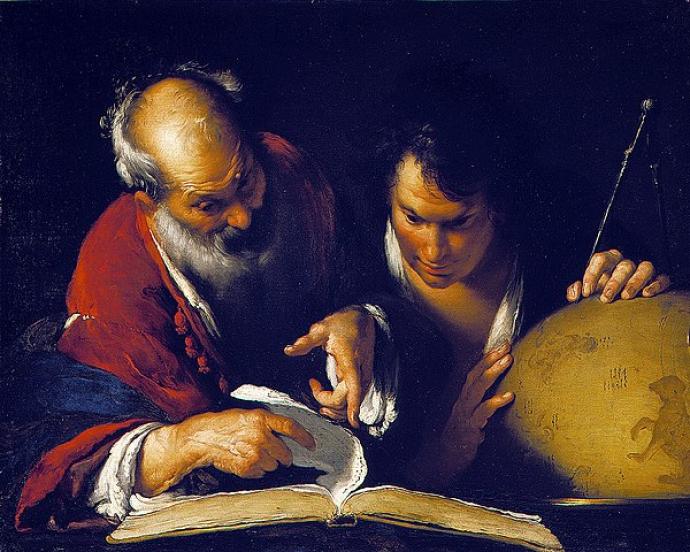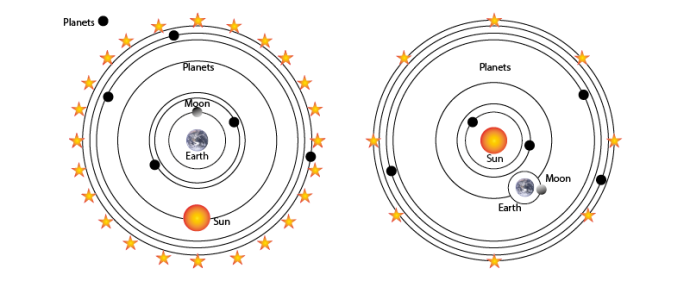Our ideas about the Solar System and space have changed over time. People have looked to the skies for thousands of years. They have looked at the movement of the stars and the changes of the Sun and Moon. Using what was known about the positions of stars, eclipses, and Moon phases star maps were made. This information was used to make calendars and measure time. It was very useful for planning when to plant crops, or for finding your way.
The first sky maps were made around 1000 BCE by the Assyro-Babylonians. Today, this area of the world is in Iraq and Syria. Here some of the first dedicated spaces were set up to study the night sky.

The ancient Greeks also did a lot of work in astronomy and maths. Eratosthenes first worked out the distance around the Earth (it's circumference) in 240 BCE. You can try out his experiment yourself on the summer solstice! Hipparchus was the first person to record the wobble of the Earth as it spins on its axis. We call this wobble precession. He was also the first to measure the distance to the Moon.
In 400 CE Hypatia was the one of the world's leading mathematicians and astronomers. She was Greek but lived in Egypt. She designed a machine, known as an astrolabe. This plotted the positions of stars in the night sky. Her tables listing the positions of the stars were used for the next 1200 years.
- The Geocentric Model
The ancient Greeks thought the Earth was the centre of the Universe. This idea is called the geocentric model which means Earth-centred.
This belief seemed to explain why stars look like they move around the Earth once a day. It also explained why planets seem to move faster than stars in the night sky.
However, this model also had problems. The main issue is that planets sometimes seem to move backwards across the sky. We call this retrograde motion. If everything in space went around the Earth this didn't make sense.
Ptolemy, a Roman who lived and worked in Egypt, tried to solve this problem in 140 CE. He used a system of circles to show how the planets moved. These were called epicycles. But the model was complicated and couldn't always predict the movement of the planets.
Despite the problems, this model of the Universe was believed for over a thousand more years.
Image CreditThis work by The Schools' Observatory is licensed under All rights reserved
CreditThis work by The Schools' Observatory is licensed under All rights reservedThe Geocentric versus Heliocentric Models - The Heliocentric Model
In 1543, Polish astronomer Copernicus said the Earth and other planets orbited around the Sun. This idea is called the x model, which means Sun-centred. This predicted the movement of the planets in the night sky without the need for complicated epicycles.
The shift from an Earth-centred view to a Sun-centred view of the Universe is called the Copernican Revolution. Though it was first mentioned over 1800 years earlier by the Greek astronomer Aristarchus! People were used to the Earth being centre of everything, so this was a big change in thinking. Many people did not accept it.
So Danish astronomer Brahe made his own model of the Solar System. It brought together the science of the heliocentric system, with the beliefs behind the geocentric one. He said that planets go around the Sun, and the Moon goes around the Earth, but that the Sun also orbits the Earth.
Brahe's observations of the planets were 5 times more accurate than any made before. He even found some 'new stars' that we know today are supernovae. He also looked at comets in more detail and found that they were not close to Earth but moving through the Solar System.
Italian astronomer Galileo first looked at the sky using a telescope. He made the telescope himself using some glass lenses. These helped to magnify the light by 30 times! In 1610, he found that Jupiter had moons going around it. This was the first evidence that objects could orbit something other than the Earth. This discovery helped to build up support for the heliocentric model.
In fact, these moons may have been seen much earlier. The Chinese astronomer, Gan De described 2 bright objects near Jupiter in 365 BCE. He made these observations using only his eyes.
There were still some problems with Copernicus's model. It assumed that the planets orbited the Sun in perfect circles. In 1609, German astronomer Kepler made the model better by using elliptical orbits for the planets instead. This system was much more successful at predicting the movements of the planets. Kepler then went on to develop his 3 laws of planetary motion.
You can use our Electric Orrery to look at how the planets orbit around the Sun. You can use it to travel into the past or to see where they will be in the future!
